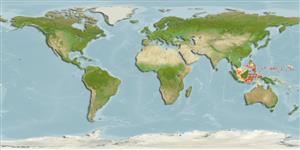Teleostei (teleosts) >
Anguilliformes (Eels and morays) >
Ophichthidae (Snake eels) > Myrophinae
Etymology: Scolecenchelys: Greek, skolex = worm (1855) + Greek, enchlys, -yos = eel (Ref. 45335).
More on authors: Weber & deBeaufort.
Issue
Regarded as a member of another genus according to Hibino et al., 2015 (Ref. 104540).
Environment: milieu / climate zone / depth range / distribution range
Ecology
Marine; demersal. Tropical
Distribution
Countries | FAO areas | Ecosystems | Occurrences | Point map | Introductions | Faunafri
Western Pacific: Indonesia.
Size / Weight / Age
Maturity: Lm ? range ? - ? cm
Max length : 10.0 cm TL male/unsexed; (Ref. 90102)
Inhabits sand bottoms near reefs (Ref 90102).
Life cycle and mating behavior
Maturities | Reproduction | Spawnings | Egg(s) | Fecundities | Larvae
Hibino, Y. and S. Kimura, 2015. Revision of the Scolecenchelys gymnota species group with descriptions of two new species (Anguilliformes: Ophichthidae: Myrophinae). Ichthyol Res (Ref. 104540)
IUCN Red List Status (Ref. 130435)
Threat to humans
Harmless
Human uses
Tools
Special reports
Download XML
Internet sources
Estimates based on models
Preferred temperature (Ref.
123201): 27.2 - 29.1, mean 28.7 °C (based on 56 cells).
Phylogenetic diversity index (Ref.
82804): PD
50 = 0.5000 [Uniqueness, from 0.5 = low to 2.0 = high].
Bayesian length-weight: a=0.00076 (0.00029 - 0.00199), b=3.06 (2.83 - 3.29), in cm total length, based on LWR estimates for this (Sub)family-body shape (Ref.
93245).
Trophic level (Ref.
69278): 3.6 ±0.6 se; based on size and trophs of closest relatives
Resilience (Ref.
120179): High, minimum population doubling time less than 15 months (Preliminary K or Fecundity.).
Fishing Vulnerability (Ref.
59153): Low vulnerability (10 of 100).
